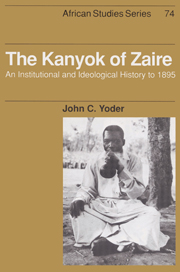Book contents
- Frontmatter
- Contents
- List of maps and figures
- Acknowledgments
- Abbreviations
- Chronology
- Introduction
- 1 Wood and wine, gardens and game
- 2 Stratification, symbols, and spirits
- 3 New legends for new leaders
- 4 Serpents and lightning
- 5 Dances, moats, and myths
- 6 Combat, classes, titles, and trade
- 7 Schisms and slaves, ghosts and guns
- 8 Assassinations, alliances, and ambushes
- APPENDIX: Methodology
- Notes
- Bibliography
- Index
- Titles in the series
5 - Dances, moats, and myths
Ilung a Cibang rejects Luba imperialism, ca. 1800 to 1825
Published online by Cambridge University Press: 29 September 2009
- Frontmatter
- Contents
- List of maps and figures
- Acknowledgments
- Abbreviations
- Chronology
- Introduction
- 1 Wood and wine, gardens and game
- 2 Stratification, symbols, and spirits
- 3 New legends for new leaders
- 4 Serpents and lightning
- 5 Dances, moats, and myths
- 6 Combat, classes, titles, and trade
- 7 Schisms and slaves, ghosts and guns
- 8 Assassinations, alliances, and ambushes
- APPENDIX: Methodology
- Notes
- Bibliography
- Index
- Titles in the series
Summary
The prolonged interregnum at the end of the eighteenth century betrayed the uncertain prospects facing the Kanyok people and their leaders. Although the extensive Luba tribute system afforded new economic opportunities, it also presented novel dangers because the same channels of travel and information granting the Kanyok access to the Luba world allowed the Luba to interfere in Kanyok affairs. Luba warriors and brigands from east of the Luembe River attacked villages, seized hostages, plundered crops, and appropriated land. Luba chiefs, eager to siphon off Kanyok wealth, monopolized the flow of tribute from the Luilu valley area. By the late 1700s, feuding Kanyok chiefs were unable or unwilling to resist these incursions and public confidence in government weakened. The old legends glorifying Luba hunter ancestors seemed meaningless as eastern Luba neighbors raided the land, and as Kanyok leaders boasting fictive Luba descent fought among themselves.
Kanyok historians claim that in this context of uncertainty and instability, an improbable savior emerged to restore dynastic fortunes and renew the people's faith in themselves, their government, and their legends. Described by the Kanyok as the preeminent figure in their history, Ilung a Cibang is said to have reorganized the Kanyok military structure, expelled or controlled the Luba invaders, expanded his authority over other regional chiefs, and extended his influence over non-Kanyok rulers to the north and east of his domain. Although Kanyok fortunes are said to have been at a nadir when Ilung took office, supposedly when he died the land was at peace, the dynasty secure, and the neighboring chiefs recognized the supremacy of the Mwen a Kanyok.
- Type
- Chapter
- Information
- The Kanyok of ZaireAn Institutional and Ideological History to 1895, pp. 64 - 80Publisher: Cambridge University PressPrint publication year: 1992



